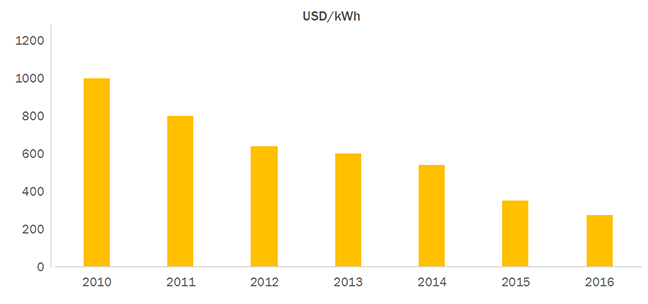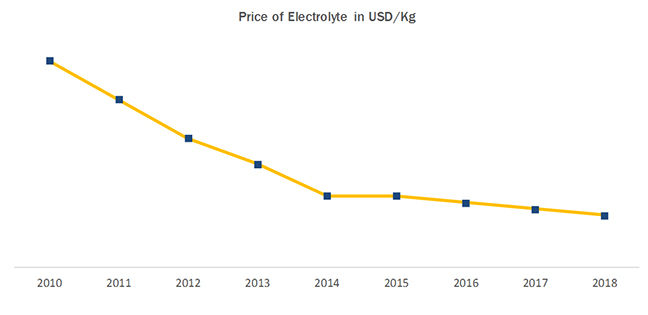Commentary Contributed by Saurabh Shelar, Analyst, MarketsandMarkets
June 14, 2018 | Electrolyte is a chemical combination of salts and solvents in fixed ratio (generally 1:4 for lithium-ion battery) to enhance the flow of ions and create a conductive medium. Lithium-ion (Li-ion) battery electrolytes are classified based on state of electrolyte into solid and liquid electrolyte. Polymer pouch batteries used in laptops and cellphones are considered as liquid electrolytes.
Salts used in the Li-ion battery includes lithium hexafluorophosphate (LiPF6), lithium perchlorate (LiClO4), lithium tetrafluoroborate (LiBF4) etc. Solvents are used in the liquid Li-ion battery electrolytes. They are carbonate based primarily due to the high solubility of lithium salts in carbonates. Carbonate based solvents are cost competitive and provide good ionic conductivity. Some of the commonly used solvents includes dimethyl carbonate (DMC), diethyl carbonate (DEC), ethyl methyl carbonate, and vinylene carbonate. Leading liquid electrolyte manufacturers include companies such as Mitsubishi Chemicals (Japan), Capchem (China), Zhangjiagang Guotai Huarong Chemical New Material Co., Ltd (China), and Ube Industries (Japan).

Unlike the liquid electrolyte, a solid-state Li-ion battery does not have a carbonate based solvent. Solid electrolytes can be broadly classified based on types into: inorganic electrolyte, solid polymer electrolyte, and organic ionic plastic crystals. Examples of commonly used solid-state electrolytes are Lithium Tin Phosphorous Sulfide and Lithium-ion Conducting Glass-Ceramics, among others. Solid electrolytes have higher energy density and better safety compared with the liquid electrolytes. However, there are some hurdles associated with this technology such as, to operate the battery it needs to be maintained at a threshold temperature of 60⁰C or it loses power and becomes empty. Also, the vehicle needs to be plugged-in when not in use. Currently, the total solid electrolyte production in the US is around one metric ton. Leading manufacturers in US include NEI Corp., Ohara Corp., CeramTec, and Ampcera Corp.
The use of solid-state electrolytes in Li-ion batteries can improve their affordability while also enhancing the safety. Leading automobile manufacturer such as BMW, Toyota, Honda, and Nissan are working on the development of Electric Vehicles (EV) using the solid-state Li-ion battery. Solid-state Li-ion battery manufacturers based in US include Samsung Ventures backed Seeo, General Motors backed Sakti3, and Volkswagen backed Quantumscape. Solid-state Li-ion battery manufacturers in APAC are also into late stages of product development. Solid-state Li-ion battery offers higher energy density and are expected to be commercialized by the above-mentioned automobile companies by the early 2020’s.
The growth of the Li-ion battery electrolyte market is directly associated with the growth of the Li-ion battery market. The Li-ion battery market is growing due to tremendous demand and adoption of the EV. Unlike the conventional vehicle that employs an internal combustion engine, an EV is considered to have zero carbon emission since they are driven by battery power train. According to Elon Musk, co-founder of Tesla, “even if majority of the electricity around the world is produced from coal, use of electric-vehicles can still bring down the carbon emission by up to 50 percent”.
Li-ion battery prices have dropped exponentially between 2010-2016 ($/kWh) from around $1,000/kWh to below $280/kWh in 2016. Figure 2 shows the drop in the prices over the years. It is expected that the prices of Li-ion batteries will drop below $150/kWh by 2022.

Electrolytes contributes around 2 percent to 10 percent of the total battery cost depending on the chemistry of Li-ion battery, for e.g. NMC, LCO, NCA, etc. Electrolyte is one of the key focus area for Li-ion battery manufacturers, with various institutions and organizations working to improve the performance parameters of batteries such as battery capacity, energy density, and reduce its cost. During 2010, 1 kg electrolyte used to cost upwards of U$30, at present in 2018, it is below $10 per kg. With increasing demand for batteries from EV manufacturers the production capacities for Li-ion batteries are being added to bring down the unit prices of these batteries.

EV’s that are currently in the market use liquid electrolyte based batteries, since the solid electrolyte based batteries are not yet commercialized due to lack of technology. To expand the share of solid electrolyte-based Li-ion batteries, a lot of green-field investment needs to be done. Only Ballore Blue Solution (France) has been successful in developing commercializing the solid electrolyte based EV. Ballore Blue Solution has a production capacity of around 500MWh to 1.5GWh, which is equivalent to 10,000 batteries.
The EV initiative has been implemented in Canada, China, Finland, France, Germany, India, Japan, Mexico, the Netherlands, Norway, Sweden, the United Kingdom and the US. According to this initiative the member nations have an ambitious target of achieving 30 percent of the vehicles on the road to be electric by 2030. This initiative has enabled high demand for EV’s in the member nation countries and is one of the major driver for the Li-ion battery market, which in turn is driving the electrolyte market.
China currently dominates both the EV market and the Li-ion battery market. The EV count for FY 2017 was more than 1 million and is growing at a CAGR of more than 20 percent every year. Leading Li-ion battery manufacturers are based in the Asia-Pacific region. Contemporary Amperex Technology Co. Ltd. (CATL), BYD, Panasonic, LG Chem, Samsung SDI, and TDK are all based in APAC. According to Dr. Thomas Sedran, Head of Strategy, Volkswagen, one cannot find insurance for Li-ion batteries, as they are not considered safe for transportation. This has resulted in overseas expansion by leading Li-ion battery manufacturers. For instance, CATL is focusing on expanding its presence by starting a new Li-ion battery manufacturing factory in Europe. Similar expansion has been undertaken by leading South Korean battery manufacturers LG Chem and Samsung SDI, who have opened facilities in Poland and Hungary respectively.
The use of renewable resources such as solar and wind for electricity generation is also on the rise. In 2017, Tesla installed world’s largest Li-ion battery in South Australia to store renewable energy and provide uninterrupted power supply during power outages. Li-ion batteries are now used for sustainable energy storage in many countries. By increasing the production of these batteries, the per unit cost is expected to fall below $80/kWh by 2030 enhancing their affordability and increasing its consumption for energy storage applications. With world shifting its focus towards sustainable energy generation, storage, and sustainable transport, demand for Li-ion batteries is expected to remain high. Favorable government policies and incentives to the Li-ion battery manufacturers, EV user growth is expected to create a growing market for battery electrolytes. For further details please refer the report Battery Electrolytes Market.







